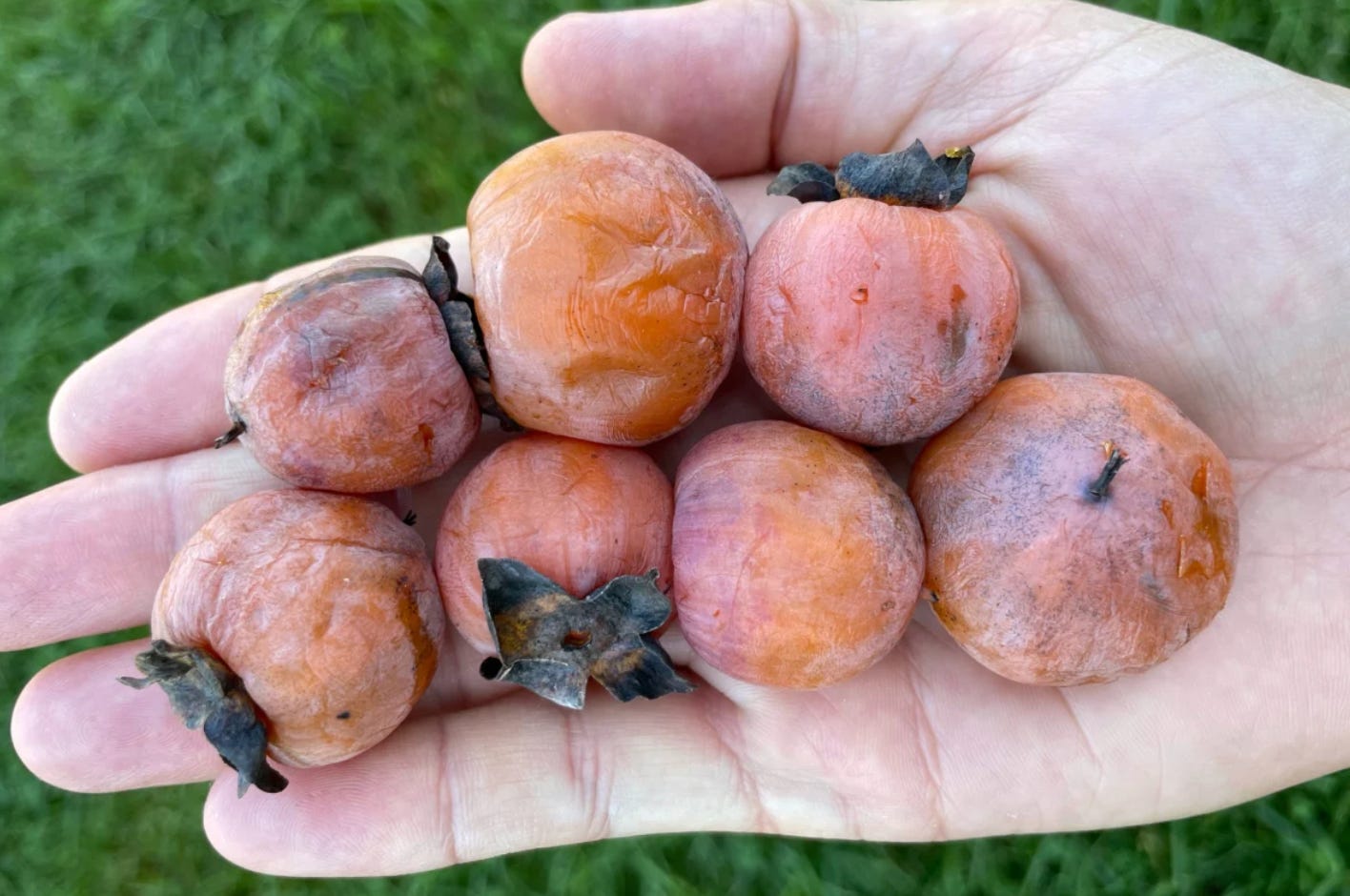If you’ve had a persimmon, then you know they are pure gold.
The genus name for persimmon, Diospyros, literally translates to “Zeus’s Wheat” or “Fruit of the Gods.” Yet, every year, I’m surprised by how many people still have never heard of—let alone eaten—a persimmon. In recent years, I’ve made it my personal mission to share the joy of a ripe persimmon with anyone I can. The key word there is ripe, because biting into an unripe persimmon was truly one of the worst things I’ve ever experienced.
I bit into my first persimmon about five years ago. Any time I see something at the farmers market that I haven’t had before, I’m sold. I picked up a persimmon at the Clark Park farmers market in West Philadelphia and went home excited to try something new. I sliced the firm fruit into a few thick chunks and took a bite, avoiding the tough skin. Before I knew it, I felt as if my mouth was coated in bitter chalk and that any remaining ounce of my moisture in my mouth had been sucked out.
Luckily, as it often does, chocolate saved the day; since water proved ineffective I grabbed the first thing I saw in my cabinet, which was a chocolate bar, and was relieved to discover it successfully dissolved the astringent coating the persimmon left behind. This reminded me of the time that, as a child, I bit into a motion-sickness pill on a car ride that definitely wasn’t supposed to be bit into and only felt relief when my parents handed me a chocolate bar in an attempt to replace the medicinal bitterness filling my mouth with something (anything) else.
Not exactly a love-at-first-bite story, is it? Needless to say, my relationship with persimmons went on a bit of a hiatus. A few years passed, I moved from Philadelphia to Washington DC, and one Sunday morning I found myself staring at locally grown persimmons at the DuPont Circle FreshFarm farmers’ market. These weren’t firm like the persimmon I previously had—they were small, a bit oblong, and so soft to the touch that if I squeezed one I thought it might pop like an overripe grape. I’ve always believed in second chances and that day I gave those persimmons theirs.
To say the proceeding experience exceeded my expectations would be an understatement. The skin on these persimmons was thin and delicate enough that I was able to bite right in, as if it were a ripe peach. This was nothing like the first go-around. Astringency absent, the taste was incredibly sweet—a bit floral and honey-like. I’ve since heard the flavor be compared to ripe apricots. The texture was similar to an extremely ripe tomato, but jammy and gooey.
If you’ve ever had a euphoric eating-a-juicy-peach-over-the-sink moment, this was like that.
Since then, I haven’t been able to get enough. If I see persimmons, I buy them. They have a relatively short season, appearing October through December depending on region, so I stock up while I can. I currently have a quart container of persimmon flesh that I peeled when ripe and froze so that I could enjoy it year round.
Once I was fully onboard the persimmon train, I began to do my research. Why did the first persimmon I tried taste so different from the ones I was now enjoying? Turns out, there are hundreds of varieties of persimmon, with the two most common varieties sold in North America being the hachiya and the fuyu. If you’re lucky, you also might be able to find the wild American persimmon. All of these varieties range from light to deep orange in color and can primarily be found across the eastern United States, all the way from the Gulf coast to Illinois and southern New England.
Fuyu persimmons, also known as Japanese persimmons, Asian persimmons, or kaki fruit, are firm, round, and short—they somewhat resemble a small beefsteak tomato. As their name suggests, these persimmons are native to East Asia, where they were the most widely grown fruit until the 20th century. If you see persimmons at the grocery store (I’ve seen them at Trader Joe’s and Whole Foods), they are likely fuyu persimmons. Unlike hachiyas and American persimmons, fuyu persimmons never become incredibly soft as they ripen. When ripe, fuyu persimmons have a crisp, sweet taste. I’ve snacked on them sliced like apples, and last year even had a delightful savory dish at Perry’s where the persimmons were served with butternut squash, apples, peanuts, and pickled sweet peppers over a bed of honey whipped ricotta (drooling on my keyboard as I write this).
Hachiya persimmons, also native to East Asia, are the variety shaped like a large acorn or Roma tomato, and are what I currently have a container full of in my freezer. They are also the variety that are extremely astringent when firm and unripe. But I’m telling you, when ripe, these babies are like candy. When they’re so ripe and squishy that you think to yourself “these must be overripe,” that’s when they’re perfect and ready to eat. Since they’re so soft when ripe, it’s more challenging to package, ship, and store hachiyas, so you’re more likely to find these at your local farmers market than at a larger grocery store (although I have found them at DC’s Union Market before). My favorite way to eat hachiyas is still like a juicy peach over the sink—they really don’t need anything else—but they can be enjoyed in many ways. I add them to smoothies (my favorite combo is persimmon, banana, mango, coconut water, and bee pollen), scoop them onto sourdough toast with ricotta and flaky salt, or mix them into my Greek yogurt in place of honey or fruit jam. They can also be used in breads and puddings (similarly to how you might use banana), although I haven’t tried that yet.
Finally, if you’re lucky, you’ll be able to find American persimmons at your local farmers market. American persimmons are a native, wild variety of the fruit that have been used in Native American cuisine for centuries. Similar to their hachiya cousins, they are incredibly sweet and should be eaten when extremely soft to the touch or else they will be bitter and astringent. They are a smaller variety, and typically range from a round shape (like an extra plump grape) to a slight acorn shape. These are the variety that I was lucky enough to stumble upon that Sunday morning at the Dupont Circle farmers market and that I will never pass up if I see.
I love cooking. I love eating and going to restaurants. I love reading about food—its taste, its creation, its history. At the core of all of these activities is my desire to discover something new. To me, nothing is more exciting than the moment you cook a new dish (and it actually turns out well), taste a new ingredient, or learn something new about the food we eat and how it gets to our plates. The only thing that might be more exciting than experiencing those moments myself is sharing them with others—if you know me, you’ve probably been a victim of one of my passionate you’ve-gotta-try-this moments.
So that’s what this blog is going to be: a place to talk about foods that have caught my attention in the hopes that the next time you’re at the farmers market, instead of passing by something you’re unfamiliar with, you’ll decide to discover something new.
It might just be your new favorite fruit.
p.s. I know it’s silly writing about persimmons when we’re far from persimmon season, but that’s just more of a testament to how good they are—they’re always on my mind :)







So excited to read more!!! Waiting for the next post!
I gotta get me a persimmon!!